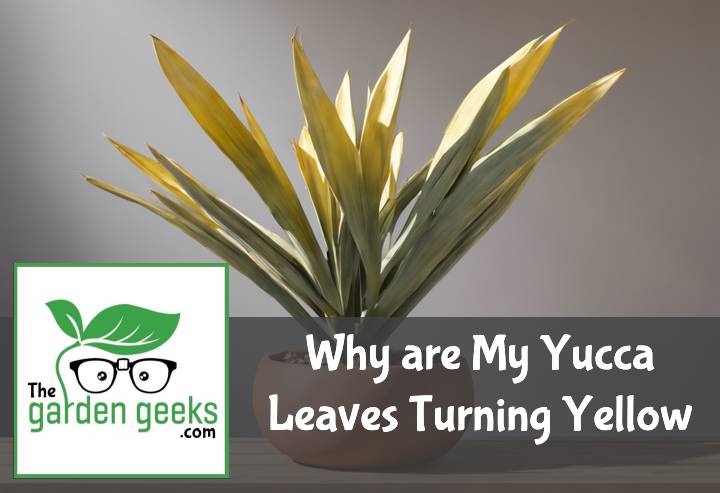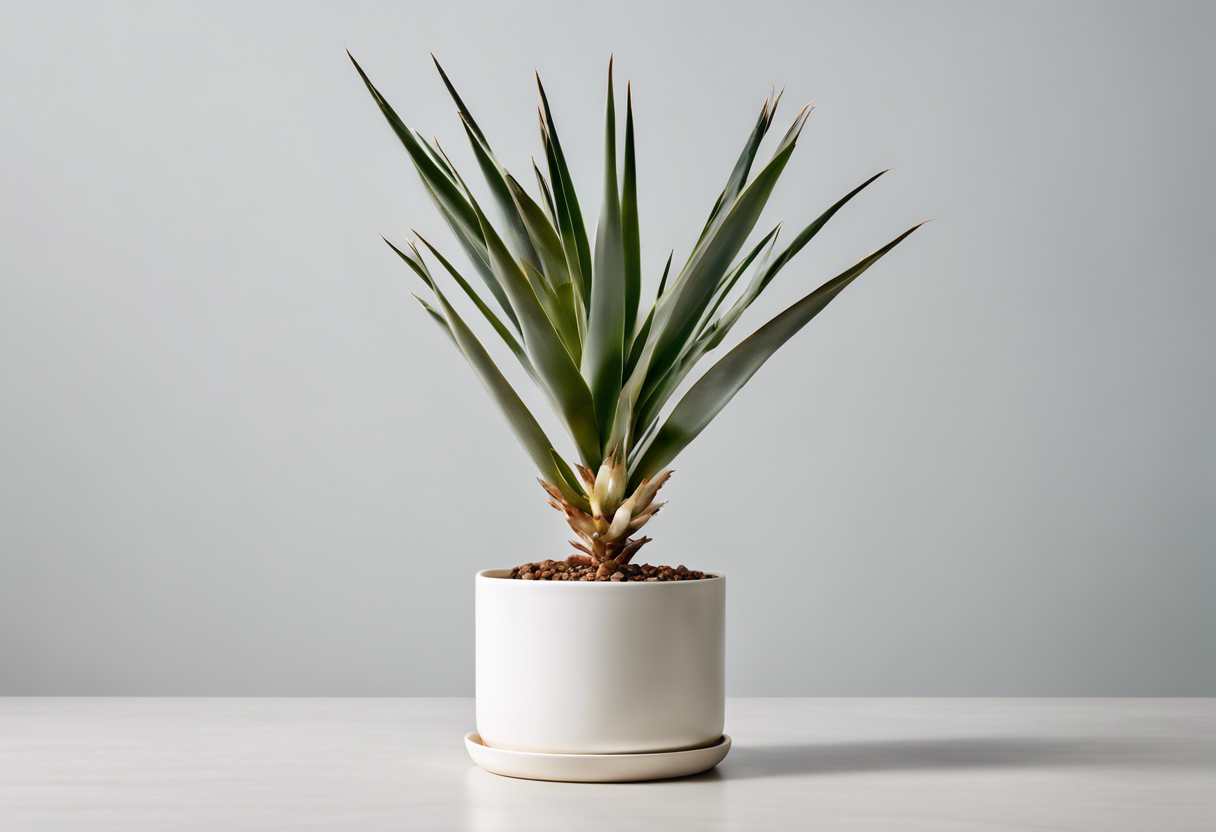Ever found yourself staring at your beloved Yucca plant, scratching your head and wondering, Why are My Yucca Leaves Turning Yellow? Well, you’re not alone. I’ve been there too, with my own indoor jungle of plants!
But don’t fret! There’s a whole world of reasons why this might be happening. From overwatering to lack of sunlight, each leaf is like a little green detective story waiting to be solved. So stick around, we’ll crack this case together! “Keep reading about Why are My Yucca Leaves Turning Yellow?”
Key Takeaways
- Yucca leaves turn yellow due to overwatering, poor drainage, and lack of sunlight.
- Overwatering causes root rot which leads to yellowing leaves. Ensure the plant is watered only when the top soil is dry.
- Poor drainage can also cause waterlogging and subsequently yellow leaves. Use well-draining soil and pots with drainage holes.
- Lack of sunlight can lead to chlorosis, causing leaves to turn yellow. Place your yucca in a location that receives ample sunlight.
Understanding Yucca Plants
Let’s talk about the yucca plant, a unique specimen with its roots (pun intended) in the deserts of America. Known for its hardiness and distinctive features, it’s a favorite among green thumbs and novices alike.
What is a Yucca Plant?
A yucca plant is like the Clint Eastwood of the plant world – tough, resilient and has an undeniable presence. Originating from arid regions of America, this plant boasts features such as sword-like leaves and towering flower stalks that make it stand out in any garden or indoor space.
But don’t let its rugged exterior fool you. The yucca plant has a softer side too – its flowers are often white and bell-shaped, adding a touch of elegance to its otherwise macho persona.
Ideal Conditions for Yucca Plants
Now, if you’re thinking about inviting Mr. Yucca into your home or garden, there are some conditions he prefers. First off, light. Yuccas love their sunbathing sessions – they thrive in bright light conditions so keep them near windows if indoors.
Next up is soil type. These plants prefer well-draining soil types to prevent waterlogging. Think sandy or gritty mixtures that mimic their natural desert habitat.
Lastly, watering needs. Despite being desert dwellers, yuccas do need water but not too much! Overwatering can lead to root rot which might be why you’re asking “Why are My Yucca Leaves Turning Yellow“. So remember folks, when it comes to watering your yuccas – less is more!
Common Reasons for Yellowing Leaves in Yucca Plants
Why are My Yucca Leaves Turning Yellow? It’s a question that can stump even the most seasoned green thumb. The answer often lies in yucca plant care, and more specifically, four common culprits: overwatering, underwatering, lack of sunlight exposure, and temperature stress.
Overwatering and Root Rot
Overwatered yuccas can be a sad sight. When you’re too generous with water, it can lead to root rot in plants. This soggy situation causes the roots to suffocate and decay.
As a result, your yucca starts sending out distress signals – one of them being yellow leaves on plants. So if you notice this symptom along with mushy stems or a foul smell from the soil, it might be time to dial back on the H2O.
Underwatering and Drought Stress
On the flip side, an underwatered yucca is no happy camper either. These desert natives are tough cookies but they still need their drink! Deprivation leads to drought stress which manifests as yellow leaves among other signs of underwatered plants.
So if your yucca’s looking more yellow than green and its leaves feel crispy to touch, it might be silently screaming for some water love.
Lack of Sunlight Exposure
Sunlight deficiency in yuccas is another reason for those pesky yellow leaves. These sun-loving beauties need their daily dose of light to thrive.
Without enough rays hitting their leaves, they start losing chlorophyll (the stuff that makes them green). And guess what color shows up when there’s not enough green? Yep, you guessed it – yellow!
Temperature Stress
Lastly, extreme temperatures can make your yucca go all mellow yellow too. Both frosty winters and scorching summers can cause temperature stress on plants.
Yuccas prefer a Goldilocks zone – not too hot, not too cold. So if your yucca’s leaves are turning yellow during a heatwave or a cold snap, it might be feeling the temperature pinch.
Nutrient Deficiencies Leading to Yellow Leaves
When your yucca starts flashing yellow leaves, it might be crying out for some nutrient love. Specifically, nitrogen and iron deficiencies can cause your plant to look a bit sickly. These are common issues in yucca plant nutrient deficiency, leading to those alarming yellowing yucca leaves.
Nitrogen Deficiency
Now, let’s talk about nitrogen. It’s like the protein shake of the plant world. Without enough of it, your yucca might start sporting yellow leaves due to nitrogen deficiency. This is one of the classic nitrogen deficiency symptoms. But don’t worry! Treating nitrogen deficiency in yuccas isn’t rocket science. A good dose of a balanced fertilizer should get your green buddy back on track.
Iron Deficiency
On the other hand, an iron shortage can also turn your yucca’s leaves yellow. It’s like anemia for plants! If you notice that new growth looks pale or yellowish, you’re likely dealing with iron deficiency symptoms in plants. But fear not! Addressing iron deficiency in yuccas usually involves adding some iron-rich fertilizer or amending the soil with iron chelates. Remember, iron plays a crucial role in plant health, so don’t skimp on this vital nutrient!
Diseases and Pests Affecting Yucca Plants
So, you’re wondering, “Why are My Yucca Leaves Turning Yellow?” Well, it could be due to yucca plant diseases or pests affecting yuccas. These little troublemakers can cause your yucca’s leaves to turn a sickly yellow.
Fungal Diseases
Now, let’s talk about fungal diseases in yuccas. These sneaky invaders can cause your yucca leaves to start yellowing. The main culprits are usually root rot and leaf spot.
Root rot is often caused by overwatering or poor drainage, while leaf spot is usually the result of high humidity. Both conditions can lead to yellowing yucca leaves.
But don’t fret! Treating these fungal diseases isn’t as hard as you might think. For root rot, try improving drainage and cutting back on watering. For leaf spot, reduce humidity around the plant and remove affected leaves.
Pest Infestations
Next up: pests! Yes, those pesky little critters that love munching on your precious plants. Pest infestations in yuccas, like scale insects or mealybugs, can also lead to leaf yellowing.
These pests suck the sap out of your plant, causing the leaves to yellow and wilt. If you see tiny bugs on your plant or sticky residue on the leaves or surrounding surfaces – bingo! You’ve got a pest problem.
Luckily, controlling these pests isn’t rocket science either. Try using insecticidal soap or neem oil for mild infestations. For more severe cases, you might need to call in professional help.
How to Treat Yellow Leaves on Yucca Plants
If you’re asking yourself, “Why are My Yucca Leaves Turning Yellow?“, don’t fret. We’ve got the answers and solutions for your yucca plant care woes. Let’s dive into the various methods to treat those pesky yellow leaves.
Adjusting Watering Practices
First things first, let’s talk water. Overwatering or underwatering can cause your yucca’s leaves to turn yellow. It’s a classic case of too much love or not enough.
The key is balance. Yuccas aren’t big fans of wet feet, so avoid overwatering. On the flip side, they also don’t appreciate being parched. So, what’s the correct watering technique for yuccas?
Well, it’s simple! Water thoroughly but infrequently, allowing the soil to dry out between watering sessions.
Modifying Light and Temperature Conditions
Next up on our list is light and temperature conditions. If your yucca isn’t getting enough sunlight or if it’s too cold, you might find yourself dealing with yellow leaves again.
Yuccas love sunlight – they’re sun worshippers! Make sure your plant gets plenty of bright but indirect light daily. As for temperature, keep it warm; these plants aren’t fans of the cold.
Addressing Nutrient Deficiencies
Nutrient deficiencies can also cause yellow leaves in yuccas. If your plant isn’t getting enough nutrients, it’ll show in its foliage.
Yuccas need a balanced diet just like us humans! They require a mixture of macro and micronutrients including nitrogen, phosphorus and potassium among others.
If you suspect a nutrient deficiency in your plant, consider using a balanced fertilizer to correct any imbalances.
Treating Diseases and Pest Infestations
Finally, diseases and pests could be causing those yellow leaves. Yuccas can fall victim to a range of diseases and pests, from fungal infections to scale insects.
If you notice any unusual spots or critters on your plant, it’s time to take action. There are various treatments available, from organic solutions like neem oil to chemical pesticides. Always remember, an ounce of prevention is worth a pound of cure!
Preventive Measures to Avoid Yellow Leaves on Yucca Plants
You might be asking yourself, “Why are My Yucca Leaves Turning Yellow?” Well, let’s get into the nitty-gritty of preventive measures. They’re your best bet in maintaining the health of your yucca plants. It’s all about proper yucca plant care, keeping those pesky yellow leaves at bay, and being a hawk when it comes to pest control and disease prevention.
Proper Plant Care Routine
First things first, you gotta have a consistent care routine. This is like the golden rule for preventing those yucca leaves from turning yellow. Watering is key here. You can’t just splash ’em whenever you remember – there’s a yucca watering schedule to follow.
Sunlight exposure is another biggie. Your yuccas need their daily dose of sunshine but don’t overdo it! Too much sun can cause leaf burn, which ain’t pretty.
And let’s not forget about soil requirements. The right soil type for yuccas makes all the difference in their overall health and happiness.
Regular Monitoring for Pests and Diseases
Now onto pests and diseases – the bane of any plant owner’s existence! Regular checks are crucial in keeping these nuisances at bay. Spotting signs of disease early can prevent your yuccas from looking like they’ve seen better days.
Keep an eye out for any creepy crawlies too. Identifying pests in yuccas early can save you a lot of trouble down the line.
Remember folks, monitoring plant health isn’t just about preventing yellow leaves – it’s about ensuring your yuccas live long, healthy lives!
To Wrap Up
So, we’ve journeyed through the desert of knowledge and discovered why your yucca leaves might be turning yellow – too much love (water), not enough sun kisses, or a pesky bug invasion. Remember, your yucca is like a tough cowboy, it likes it dry and sunny.
For more yucca TLC tips, mosey on over to Why are My Yucca Leaves Turning Yellow. Keep those green thumbs up!





